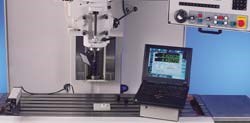Improving Productivity With Calibration
Shop managers have understood the benefits of volumetric calibration and compensation of machine tools for a while, but the technique rarely has been used because it has been too expensive and too complicated.
Share


Hwacheon Machinery America, Inc.
Featured Content
View More







Shop managers have understood the benefits of volumetric calibration and compensation of machine tools for a while, but the technique rarely has been used because it has been too expensive and too complicated. Optodyne, Inc., of Compton, California, is now offering a volumetric calibration and compensation system that can do volumetric calibration and compensation of a single machine in about 2 to 4 hours. Optodyne officials compare this to other methods that typically take 2 business days for volumetric calibration of a machine tool, with linear calibration often requiring a full 8 hours.
This system, consisting of the MCV-500 laser calibration equipment and SD-500 Vector measurement software, is priced in the $13,000 range, making it affordable for many medium sized shops.
According to Optodyne, a regularly calibrated machine ensures high repeatability. If the machining process is correct, the parts are correct—all of the parts. And this translates into higher productivity and cost-effectiveness. So the bottom line is driving the trend toward regular volumetric calibration and compensation of metalworking machines, Optodyne officials say.
At the heart of Optodyne's calibration system is Laser Doppler Displacement Meter technology. The system measures linear position errors, vertical straightness errors and horizontal straightness errors for all three linear axes. It also measures three squareness errors. When a machine tool's volumetric errors are measured, it can be compensated over the whole volume, which improves the overall accuracy of the machine tool, not simply its linear displacement, developers say. The Optodyne system can determine volumetric accuracy with only four body diagonal displacement measurements. According to the company, body diagonal displacement errors are sensitive to all the volumetric error components and therefore make an efficient test of volumetric accuracy.
The system needs four setups to detect nine sets of errors, based on efficient measurement of body diagonals. The working volume of a typical VMC has eight body diagonals, a diagonal being defined by starting at one corner of the base plane and moving to the opposite corner at the top plane. The positive or negative axis movement defines these body diagonals. The last four body diagonals are the same corners as the first four diagonals, except the directions are reversed.
Hence there are only four body diagonal directions with forward movement and reverse movement (bi-directional), and there are only four setups.
For each setup, the machine spindle movement along each of the diagonals is measured by first executing the X, then the Y, and finally the Z portion of the spindle travel. Readouts are taken and recorded at each intermediate step. This method demonstrates how three displacement errors, three vertical straightness errors and three horizontal straightness errors are measured with only four setups. For this reason, a three-axis machine tool with a one-meter cube volume can be checked in about 4 hours.
In many applications, fixtures and tooling do not have to be removed, and enclosures do not have to be dismantled. According to the company, the system is designed so that it can be set up and operated by shop floor personnel, with two to three hours needed to learn how.
By measuring volumetric errors, Optodyne's software can generate a compensation table, which can be downloaded to the control. The table compensates for errors detected in the machine tool's whole volume. Optodyne claims that the gain in accuracy reduces the bandwidth of errors by a factor of four, going from a typical volumetric error of 0.060 mm down to 0.015 mm.
Compensation file formats are available for Giddings & Lewis, Milltronics, Siemens 840, Fanuc 15 and Fanuc 16 controls, with others in development.
The Optodyne laser system is calibrated and traceable to NIST, and software analysis supports various industry standards such as ISO 230-2 and ASME B5.54. To make data collection and analysis easier, the MCV-500 can be connected to most Windows-compatible notebook or desktop computers through an RS 232 port. Windows supported software provided with the system enables automatic collection and analysis of data.
Related Content
The Power of Practical Demonstrations and Projects
Practical work has served Bridgerland Technical College both in preparing its current students for manufacturing jobs and in appealing to new generations of potential machinists.
Read MoreCan ChatGPT Create Usable G-Code Programs?
Since its debut in late 2022, ChatGPT has been used in many situations, from writing stories to writing code, including G-code. But is it useful to shops? We asked a CAM expert for his thoughts.
Read MoreHow to Mitigate Chatter to Boost Machining Rates
There are usually better solutions to chatter than just reducing the feed rate. Through vibration analysis, the chatter problem can be solved, enabling much higher metal removal rates, better quality and longer tool life.
Read MoreAutomated CAM Programming – Is Your Software Really Delivering?
A look at the latest automation tools in Autodesk Fusion 360 software and how forward-thinking machine shops and manufacturing departments are using them to slash delivery times and win more business.
Read MoreRead Next
Registration Now Open for the Precision Machining Technology Show (PMTS) 2025
The precision machining industry’s premier event returns to Cleveland, OH, April 1-3.
Read MoreBuilding Out a Foundation for Student Machinists
Autodesk and Haas have teamed up to produce an introductory course for students that covers the basics of CAD, CAM and CNC while providing them with a portfolio part.
Read More5 Rules of Thumb for Buying CNC Machine Tools
Use these tips to carefully plan your machine tool purchases and to avoid regretting your decision later.
Read More




































.jpg;maxWidth=300;quality=90)











